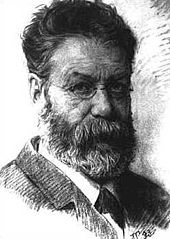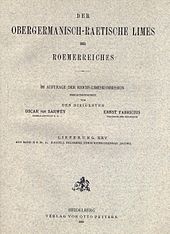Reich Limes Commission
The Reichs-Limeskommission ( RLK ) should research the course of the Upper Germanic-Raetian Limes and the location of the associated forts from Roman times. It was the first institution after the unification of the empire in 1871 to deal with a cross-border historical project.
requirements
The resulting 100 AD Upper German-Rhaetian Limes, since 2005, World Heritage of UNESCO , interested as external border of the Roman Empire since the 16th century, the scholars. Aventinus was the first to deal with a supposed part of the Limes near Eichstätt , which he ascribed to the emperor Probus . Up until the 19th century theories about the Limes were repeatedly put forward. Christian Ernst Hanßelmann deserves special respect , who in the 18th century recognized the connections between the Rhaetian Wall in Bavaria and the remains of the Wall in the Taunus . The archaeological remains were increasingly inventoried and protected. The Archeology Association in Ellwangen , which began major investigations in 1819 , stood out in particular .
In 1852 the Commission for the Exploration of the Limes Imperii Romani was founded. Several associations tried to conduct research systematically and across state borders. But the still independent states of the German Confederation wanted to maintain their cultural sovereignty on their territory even after the unification of the empire . In 1877 and 1888, state Limes Commissions were set up in the Kingdom of Württemberg and in 1880 in the Grand Duchy of Hesse and the Grand Duchy of Baden , and they were able to successfully demonstrate the course of the Limes in several places. However, this individual research could not answer all questions by far.
Since 1883, a group of researchers and interested parties around the ancient historian Theodor Mommsen , who had been calling for the organization and financing of central Limes research since the founding of the empire, had been pressing for a solution. A first attempt failed in 1873 because of the personnel issue, a second attempt at least led to an organizational plan in 1878. In addition to Theodor Mommsen, Major General a. D. Karl von Veith , representative of the Prussian General Staff , Heinrich von Sybel , Georg Waitz and Richard Schöne . The work should be carried out by officers with the support of people who are familiar with the area. The cost was estimated at 150,000 Reichsmarks . But the project ultimately failed in the Reichstag in 1882 because the MP Wilhelm Oechelhauser took offense at the leadership of the General Staff and the Berlin dominance of the project.
Mommsen's further attempts initially failed because he had come into political opposition to Otto von Bismarck and had lost his support.
founding
However, after Mommsen had turned to his colleagues in the southern countries of the empire, especially Heinrich von Brunn , a treaty was finally concluded between the five participating states through their contacts. On December 28, 1890, there was a Limes conference in Heidelberg . All five states sent their own representatives. Baden was represented by Karl Zangemeister and Ernst Wagner , Bavaria by Karl Popp and Heinrich von Brunn, Hessen by Friedrich Kofler , Prussia by Friedrich Wilhelm von Leszynski , Heinrich Nissen and Mommsen, Württemberg by Ernst von Herzog and Eduard Paulus . Additionally took Wilhelm Conrady and Louis Jacobi part. The selection was indirectly controlled by Mommsen. All those appointed had previously dealt with Limes research. Binding decisions were not possible, but the recommendation was made to set up a commission of eight people. One representative each from the states concerned, one member each from the Royal Prussian and Bavarian Academy of Sciences and a second representative from Württemberg, where the longest stretch of the Limes ran. The seat should be Heidelberg, the Limes should be divided into sections ("routes"), which should be numbered and assigned to volunteer route commissioners . Route commissioners should preferably be high school teachers, leaders of local clubs and officers. The project was estimated to be five years and a budget of 130,000 Reichsmarks. A day later, as a precaution, this amount was increased to 200,000 Reichsmarks. The work program was approved without objection.
Everything seemed to be going according to plan, with the first installment paid in September 1891. But then the budget commission of the Reichstag refused to take over the costs for financial reasons. But personal motives also played a role. On January 16, 1892 there was a debate in the Reichstag, during which Mommsen was even accused of plagiarizing Karl August von Cohausen's ideas and was personally attacked. Rudolf Virchow defended Mommsen and finally the budget was released.
Start of work
From April 7th to 9th, 1892, the first quorum meeting of the Limes Commission took place in Berlin . With the exception of Jacobi and Paulus, the participants corresponded to those of the Heidelberg meeting. Hesse now sent Wilhelm Soldan , Prussia now also Cohausen, who at Mommsen's instigation had not been invited to the Heidelberg meeting. In addition, the Düsseldorf state director Wilhelm Klein and the high ministerial official Friedrich Althoff, as well as the representative of the Reich Office for the Interior, the Secret Upper Government Councilor Schroeder took part. The resolutions of the first meeting were largely confirmed, the most important innovation was that an executive committee was set up, to which Zangemeister as chairman as well as Herzog and Popp belonged. With the consent of the participating governments, the statute entered into force on May 17th. The constituent meeting of the commission took place in Heidelberg on June 6th and 7th, 1892. Mommsen was elected chairman and Brunn his deputy. After decades of preparatory work, work could now begin. Until 1898, the Trier museum director Felix Hettner was the archaeological director of the investigations .
The work of the commission was extremely productive and dragged on for more than four decades, mainly because of the exploration of the forts. Since 1902 Ernst Fabricius (professor of ancient history in Freiburg) was head of the Reich Limes Commission. The series of publications, the “Limeswerk”, The Upper Germanic-Raetian Limes of the Roman Empire , appeared between 1894 and 1937 in 56 deliveries.
The commission divided the route as follows, based on the administrative boundaries of the time:
- Route 1: Rheinbrohl - Bad Ems
- Section 2: Bad Ems– Adolfseck near Bad Schwalbach
- Route 3: Adolfseck near Bad Schwalbach– Taunus –Köpperner Tal
- Section 4: Köpperner Tal - Wetterau - Marköbel
- Section 5: Marköbel– Groß-Krotzenburg am Main
- Line 6a: Seligenstadt - Wörth am Main (older Main line)
- Section 6b: Trennfurt ( Klingenberg am Main ) - Miltenberg
- Route 7: Miltenberg – Rehberg
- Route 8: Rehberg– Walldürn - Buchen (Odenwald) - Osterburken - Jagsthausen (newer Odenwald line)
- Route 9: Jagsthausen - Welzheim - Haghof
- Route 10: Wörth am Main - Bad Wimpfen (older Odenwald line)
- Section 11: Bad Wimpfen– Köngen (Neckar line)
- Route 12: Haghof– Lorch (end of the Upper German Limes), (beginning of the Raetian Limes) - Aalen –Mönchsroth
- Route 13: Mönchsroth– Gunzenhausen
- Route 14: Gunzenhausen - Weißenburg - Kipfenberg
- Route 15: Kipfenberg– Eining Castle
Rating
The work of the commission is considered to be one of the pioneering work in the processing of provincial Roman archeology. Much has been done to preserve the Limes in the wake of this research. For example, the Saalburg castle in the Taunus was partially reconstructed in 1897 at the suggestion of Kaiser Wilhelm II .
The End
The Reich Limes Commission was dissolved in 1937. It was incorporated into the Roman-Germanic Commission of the German Archaeological Institute , which keeps its archival legacy.
The German Limes Commission , which was founded in connection with the registration of the Upper German-Raetian Limes as a UNESCO World Heritage Site, has existed as a successor organization since 2003 .
Publications
- Ernst Fabricius , Friedrich Leonhard, Felix Hettner, Oscar von Sarwey (among others): The Upper Germanic-Raetian Limes of the Roman Empire . Edited by the Reichs Limes Commission. At least 15 vols. O. Petters, Heidelberg-Berlin-Leipzig 1894–1937 (Codex-Verlag, Böblingen 1973 (partly reprint), Greiner, Remshalden 2005ff. (partly reprint). ISBN 3-935383-72- X ).
- Jürgen Oldenstein (Ed.): Find index to The Upper Germanic-Raetian Limes of the Roman Empire . Zabern, Mainz 1982, ISBN 3-8053-0549-4 .
- Reichs Limes Commission (Ed.): Work plan . Heidelberg 1892–1898. (Print editions and films, Heidelberg University Library).
- Report on the work of the Reichslimeskommission . de Gruyter, Berlin 1892–1897, Reimer, Berlin 1898–1903. (Print editions and film adaptations Heidelberg UB, Speyer Pfälzische LB).
- Annual report of the conductors, based on d. § 9 d. Statute d. Reich Limes Commission . Freiburg Br.-Trier-Charlottenburg 1892–1904. (Print editions and film adaptations of Heidelberg University Library and others).
- Limes leaf. Notices from the route commissioners to the Reichslimeskommission . Trier 1, 1892-7, 1903, no. 1–35 ( digitized from Heidelberg University Library ).
literature
- Kurt Böhner : The archaeological exploration of the "Devil's Wall". For the 100th anniversary of the Reich Limes Commission. In: Nürnberger Blätter zur Archäologie 9, 1992–93, pp. 63–76.
- Rainer Braun: The history of the Reichs Limes Commission and its research. In: The Roman Limes in Germany . Theiss, Stuttgart 1992 (special issue Archeology in Germany ) ISBN 3-8062-1024-1 pp. 9–32.
Individual evidence
- ^ Hans Lehner: Felix Hettner . In: West German magazine for history and art. Volume 21, 1902, pp. 348-351, 354.









